Background of the Fiat CR.42 Falco
The story of the last biplane to serve in World War 2 starts during Italy’s transition to monoplane fighters in the late 1930s. General Giuseppe Valle, Chief of Staff of the Regia Aeronautica, ordered the production of the Fiat CR.42 Falco as a transition fighter during the conversion to the new monoplane interceptors.
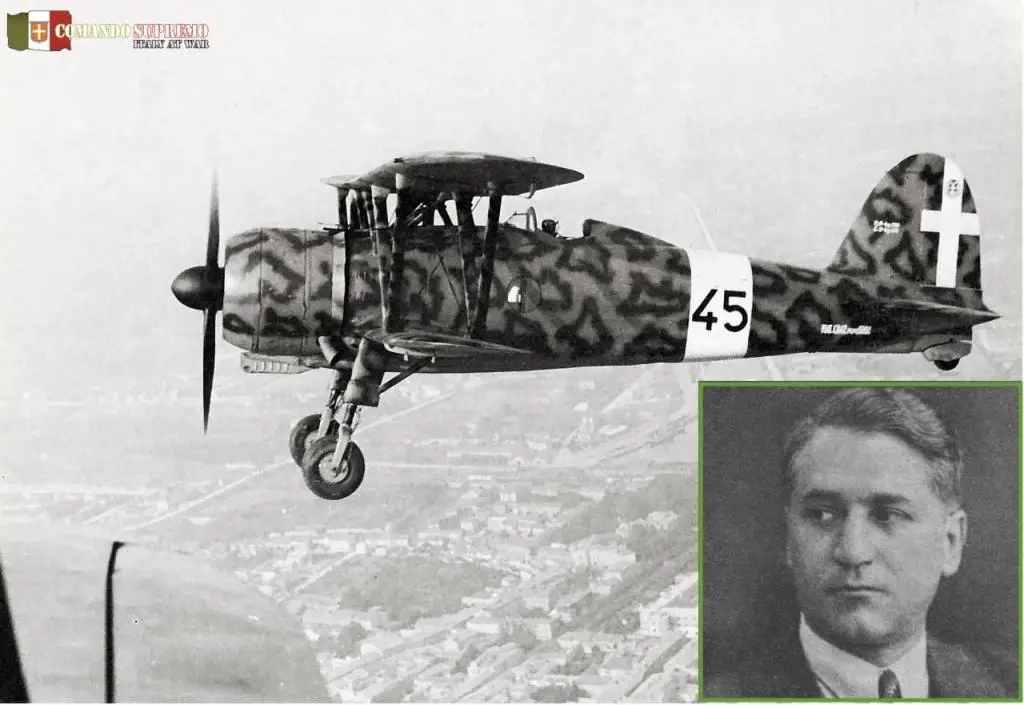
A Fiat CR.42 Falco in flight. Designer Celestino Rosatelli pictured in the insert.
Designer Celestino Rosatelli obtained valuable experience from designing exceptional biplanes such as the CR.30 and the Fiat CR.32. The Falco was no exception. Rosatelli designed the first prototype in early 1938 and on 23 May 1938, it flew for the first time. The aircraft displayed excellent flying characteristics from the start. In fact, the Regia Aeronautica ordered 200 of these aircraft before even receiving the results of the test trials. This large order amount even exceeded Regia Aeronautica’s requests for the Macchi C.200 and Fiat G.50 monoplane fighters.
An interesting note is that production stopped for both the C.200 and the G.50 by mid-1942. However, the production of the CR42 transition fighter continued into 1943.
Capabilities
Powered by the reliable 840 hp Fiat A.74 RC.38, the Falco entered service with 53° Stormo in May 1939. By the time Italy entered the war, the Regia Aeronautical already fielded 300 of these aircraft in its inventory. The Fiat CR 42 constituted about 40% of the Regia Aeronautica strength. The Biplane could reach a speed of 272 mph at 15,000 ft, with a service ceiling of 32,970 ft and a range of 481 miles. The biplane came armed with two 12.7 mm machine guns and could carry 440 lbs of bombs.
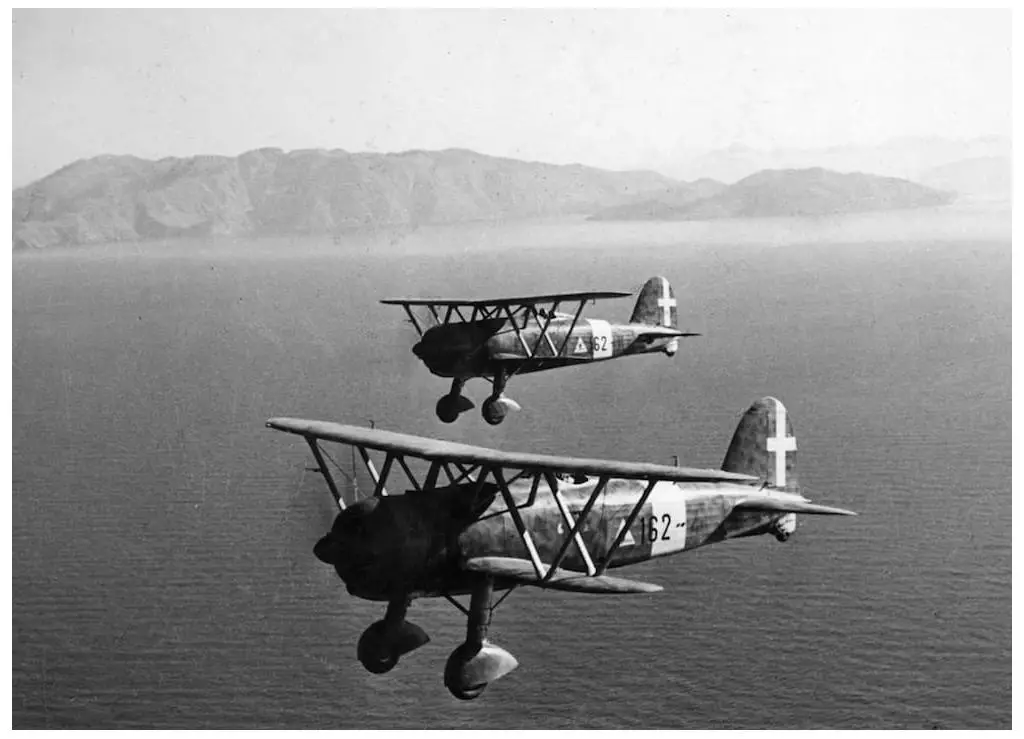
Two Fiat CR42 of the 162nd Squadron over the Aegean in 1940.
Foreign Orders
The aircraft received several foreign orders:
- Hungary (52 examples)
- Belgium (40 examples)
- Sweden (72 examples)
Fiat CR.42 Aces of World War 2 (Aircraft of the Aces Book 90)
Hungarian Operational Use
Hungary purchased the Italian biplane for its Magyar Királyi Légierö and placed orders for 52 aircraft during the summer of 1938. It equipped four squadrons, the 1/1, 1/2, 1/3 and 1/4 of 1st Fighter Regiment by late spring of 1940.
The Hungarian Air Force flew numerous sorties during the assault on Yugoslavia launched on 06 April 1941. Two months later 12 Fiat Falcos of the Hungarian 1/3 Squadron participated in the invasion of the Soviet Union. After five months of continuous operations, the serviceability of the Hungarian Air Force Brigade deteriorated rapidly and therefore recalled back to Hungary. These biplanes became relegated to a training role. During its service in the Soviet Union, the 1/3 Squadron flew some 300 sorties, destroying approximately 37 Soviet aircraft in combat for the loss of two CR. 42s.
Belgian Operational Use
In late September 1939, the Belgian government purchased 40 Fiat Falcos to meet the urgent re-equipment needs of its air arm’s IIème Group de Chasse. The order wasn’t completed because of the start of hostilities, so only 26 CR42s could be delivered. The aircraft joined the 3e and 4e Escadrilles of 27éme Regiment. They fought against the Luftwaffe starting on 10 May 1940 and conducted 35 operational missions. the Belgian biplanes claimed five aerial victories for the loss of only two Fiats before Belgium’s surrender on 28 June.
Swedish J-11 Operational Use
Sweden purchased Falcos along with an order of 120 Reggiane Re.2000 fighters. The 72 Fiat CR 42s ordered was the largest foreign purchase for the aircraft. Sweden designated the Re.2000 as the J20 and the CR.42 as the J11. Delivery of the J11s occurred between February 1940 and September 1941. By November 1941 All Fiat biplanes had arrived and assigned to the F 9 Air Wing at Säve, Gothenburg. Modifications included 20 mm armor plating behind the pilot, radio equipment and skis for winter service.
By 1945, the Falco became obsolete and AB Svensk Flygtjänst purchased the remaining aircraft for use as target-tug aircraft in the post-war years.
Actions in France and East Africa
The first operations of the Fiat CR.42 in World War II took place against France after 10 June 1940. The attacks originated from Falcos of 53° Stormo (150° and 151° Gruppi) and of 3° Stormo (18° and 23° Gruppi). The 13° Gruppo in Libya began operations against British forces a few days later. On the French front, the biplanes claimed ten victories against five losses. However, this statistic is optimistic. A 1:1 ratio is closer to the truth. In Africa, the most intense operations took place in Somalia and Ethiopia. There, the Comando Africa Orientale Italiana possessed 36 Falcos and employed them until 19 August 1940 and obtained air superiority against the RAF. But losses and attrition were great.
Notwithstanding the further 51 biplanes transported dismantled inside SM.82s, the difficulty in overcoming the isolation of the AOI took its toll and aircraft inventory began to drop. By January 1941 the available aircraft steadily diminished, dropping from 26 on 10 January 1941, to only five by mid-April. The only two surviving Fiat Falcos managed to fight up to October 1941. However by 27 November 1941, the AOI was lost including the Falcos.
Actions in the Battle of Britain
Fiat Falcos took part in the Battle of Britain with the infamous Corpo Aereo Italiano (C.A.I.). Designed more as a propaganda operation in having Italian aircraft engage the RAF in the Channel, the ill-conceived operation showed the limitations of Regia Aeronautica.
The 50 Fiat CR. 42s operating with CAI belonged to the 18° Gruppo. On 19 June 1940, they transferred to the Belgian airfield at Ursel. The first action took place on 29 October 1940 when 39 Fiat biplanes escorted Br.20s over Ramsgate. On 11 November 40 Falcos escorted the bombers over Harwich. Spitfires and Hurricanes intercepted them causing the loss of three CR42s. Another nineteen crash-landed in Belgium caused by the lack of fuel during combat. The last action of November took place on the 29th between Margate and Folkstone with a dogfight against Spitfires causing the loss of two more Falcos.
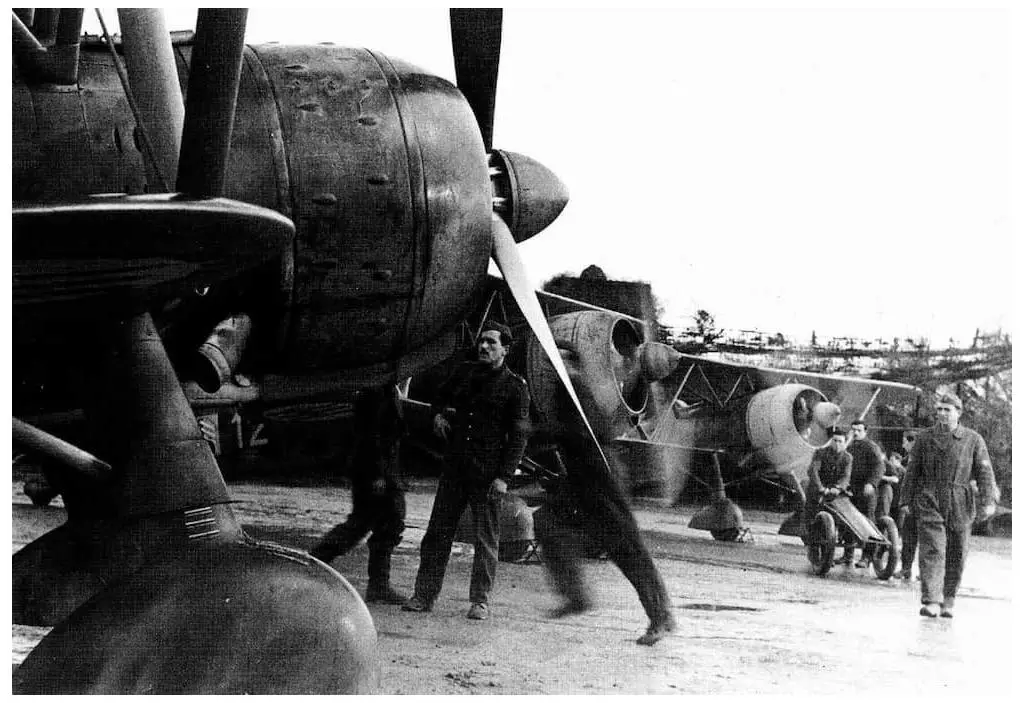
Fiat CR-42 Falco in Ursel, Belgium 1940.
The British losses are still uncertain if any. On 10 January 1941, the Falcos returned to Italy. The lack of heating equipment, open cockpits, primitive radio sets transformed the operation into a real nightmare for those involved. Additionally, the lack of navigational capabilities of the Italian pilots over the channel was non-existent. This specific training only became available after 1942.
Falcos in North Africa
The Fiat CR.42 operated in better conditions on the North African front. The 127 Falco assigned to the 13° Gruppo, 10° Gruppo and 9° Gruppo operated against an enemy equipped with the Gloster Gladiator. The Gladiator can be considered an equivalent biplane fighter. The first dogfight occurred on 19 November 1940 and involved Italian units against the Australian 3 Sqn. RAAF. Additional engagements occurred on 10 December and 26 December. Additional aircraft arrived from Italy, among them those of 18° Gruppo, coming from CAI. The Italian retreat and loss of Cyrenaica by February 1941 brought the loss to over 400 aircraft. Many of the aircraft were destroyed on the ground during the enemy advance.
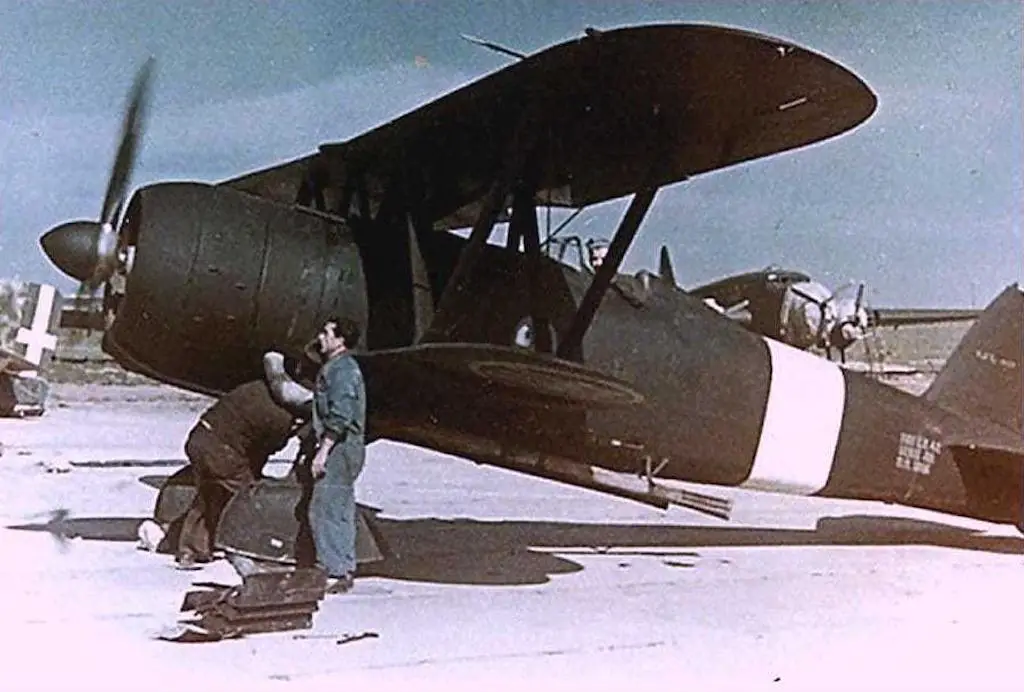
A Fiat CR 42 on the flight line in 1941.
With the arrival of German troops and the start of the new offensive, the CR.42 biplane increasingly toon the task of providing close support to the ground units. In April 1941, the first aircraft equipped for Africa Settentrionale arrived. The aircraft was equipped with sand filters and attachment points for two bombs. Outclassed by the Hurricanes, Falcos began reducing their escort duties and aircover operations. However, the CR.42 progressively took on other roles such as light ground support and reconnaissance while better interceptors made their way into the theatre.
The aircraft performed this role with 160° Gruppo, 158° and 159° Gruppi, constituting 50° Stormo Assalto, 101° Gruppo Assalto and 15° Stormo Assalto. On many occasions, the Falcos showcased the bravery of its pilots. By early 1943 the surviving 82 examples returned to Italy from Tunisia following the collapse of the North African front.
Actions in Greece, Crete, and Malta
The operations against Greece involved 46 Falcos of the 150° Gruppo. Initial attacks targeted Greek aircraft and later against the RAF. Cumulatively, the Regia Aeronautica lost approximately twenty Fiats by the end of the campaign. In late May 1941, CR 42s of the 162a and 163a Squadriglia operated in the Crete campaign as fighter-bombers. The offensive against Malta started on the first day of the war and involved aircraft of 17° Gruppo, 23° Gruppo, and the 9° Gruppo, before its transfer to Libya.
After a full year of dogfights, the RAF claimed the downing of 16 Falcos over Malta. An additional seven claimed as probable and six claimed as damaged. In total, RAF claimed 106 downing, 47 probable and 38 damaged over Malta. By 1942, these biplanes became replaced by Macchi C.202s and the Reggiane Re.2001s.
Escort Role
Another task undertaken by this biplane included the convoy-escort role. Between 1940 and 1942 many missions were conducted from Sardinia and Sicily to protect convoys headed to and from Libya. A few Falcos performed an anti-shipping role with their two 100 kg bombs. Some successes were obtained and the biplanes based in Sardinia took part in Operation Pedestal or “Battaglia di Mezzo Agosto” of 1942 with eight CR 42s.
Night Fighters
The Falco was used also as night-fighter. The first attempt was conducted in Libya by using normal aircraft in good visibility during adequate moonlight. Five enemy aircraft were downed during 1941. Later, several Falcos became modified with shrouded exhausts, complete navigational instruments, and radio equipment. Some operated in Sicily with the 171° Gruppo in late 1941. However, by the end of 1942, no more than seven remained operational. By late 1942, two-night fighter groups, the 59°, and 60° were based in Northern Italy. Additional nigh fighter groups included the 167° Gruppo in Central Italy and several autonomous units in Southern Italy and the islands. A total of about 80 CR42 CN (CN = Caccia Notturna) were used. Successes were rare due to the improved performance of enemy aircraft.
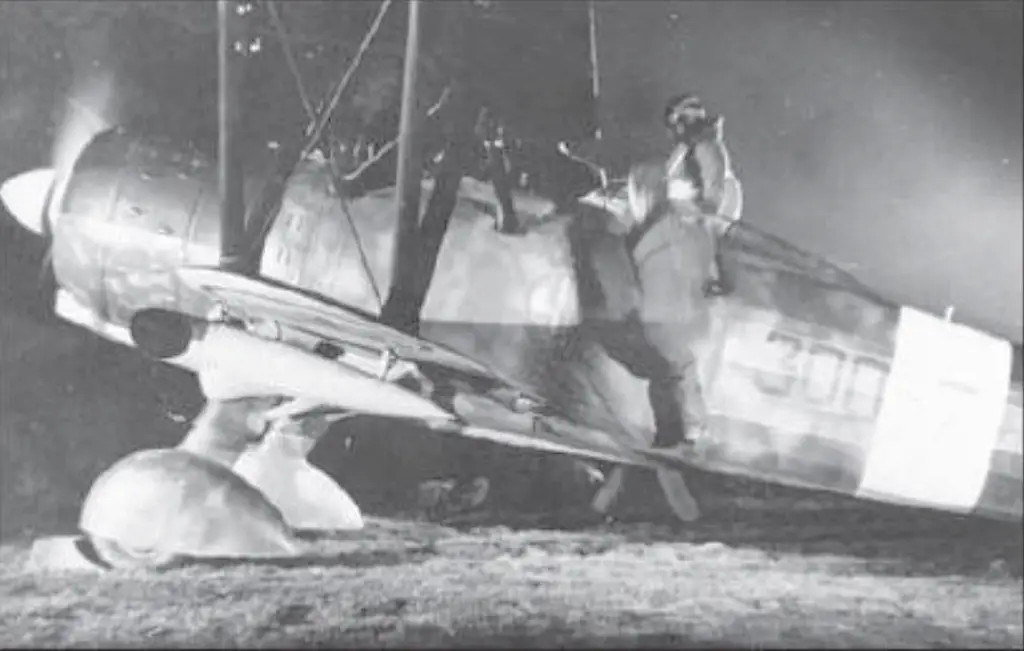
A Falco assigned to 167° Gruppo Autonomo’s 300 Squadriglia.
Following the armistice, the Luftwaffe envisioned the role of the remaining Falcos as a night fighter. Several biplanes became modified by the Fiat factory and brought up to German standards. They joined the NSGr.7 and NSGr.9 (Nachtschlachtgruppe = Night Harassment Gruppe). The former operating in the Balkans up to the end of the war and the latter in Italy, namely over the bridgehead of Anzio, until replaced by the more efficient Ju 87 Stuka in June 1944.
After the Armistice
Fiat CR42s were still used by 08 September 1943 following the signing of the Armistice. At this point, Germany seized most of the surviving aircraft, mainly for use in piloting schools. An additional few became employed with the Italian Cobelligerent Air Force and the ANR, but only as liaison planes and as trainers. About forty aircraft survived the end of the war and almost twenty of them continued service into the late 1940s by the Italian Air Force as trainers.
The career of the Falco thus ended. A sort of monument to a great plane. The last of its era. But also a monument to the inability of the Regia Aeronautica to develop a replacement for an aging aircraft representing an already obsolete formula.
A total of 1,782 Falcos were built.
Variants
Egeo: Equipped with an extra 20-gallon tank (80 L)
ASA: Close air-support: Designed for North Africa operations. Includes sand filters, (2) 12.7 mm machine guns with an option for two additional and racks for two 220 lb (100 kg) bombs.
BA (AKA: CR42DB): Powerplant changed to a Daimler-Benz DB601.
CR 42bis: (2) 12.7 mm machine guns.
CR 42 CN: Night fighter version.
ster: (2) 12.7 mm machine guns with two additional under the wings.
ICR42: Float Plane version.
LW: Night version anti-partisan duties for the Luftwaffe. It includes four 50 kg bombs (150 built)
“Bombe Alari”: Ground attack version. Aircraft hold (4) 110 lb (50 kg) bombs were added.
two-seater: Two-seater communications aircraft.
CR42DB: Only one built with a DB 601A engine with 1,200 hp. This aircraft reached a speed of 326 mph (525 km).
Specifications
| Model | Fiat CR.42 |
|---|---|
| Crew | 1 |
| Length | 27 ft 1 in (8.21 m) |
| Wingspan | Top: 31 ft 10 in (9.70 m) Bottom: 21 ft 4 in (6.50 m) |
| Height | 10 ft (3.585 m) |
| Powerplant | (1) Fiat A.74 RC38 (840 hp) |
| Speed | 274 mph (441 km/h) at 20,000 ft |
| Weight | Empty: 3,929 lb (1,782 kg) Max: 5,060 lb (2,295 kg) |
| Range | 485 miles (780 km) |
| Service Ceiling | 33,500 ft ft (10,210 m) |
| Armament | (2) 12.7 mm Breda SAFAT machine guns (2) 12.7 mm machine-guns 440 lb (200 kg) bomb load |
